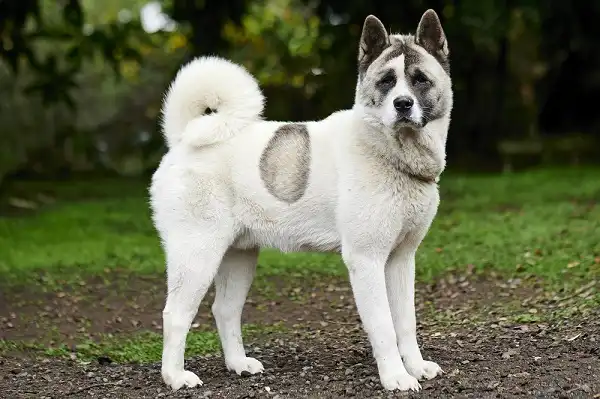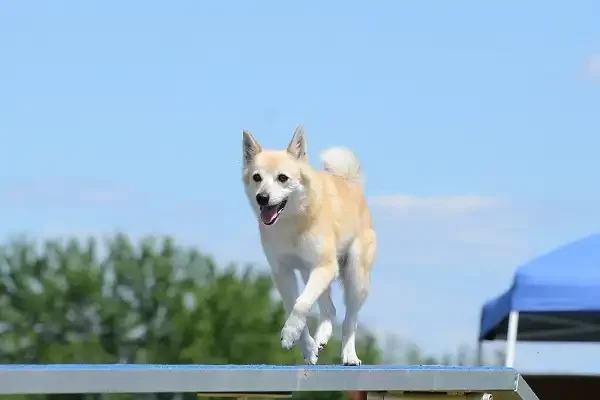Are you looking for an energetic and friendly pup to add to your family? Then look no further than the Norwegian Buhund – a medium-sized spitz breed with origins dating back to at least 900 A.D. This lively Nordic dog is full of spirit, has tons of personality, and often gets nicknamed “the little Viking”! While they make wonderful companion animals for families in search of a loving pet, the Norwegian Buhund also excels as a working herder or guardian due to its strong sense of loyalty and devotion. Read on to learn more about this endearing pooch!

Norwegian Buhund Description
The Norwegian Buhund boasts a robust, compact build that is well-suited to its original purpose as a herding dog on Norwegian farms. Their sturdy bodies are adorned with a dense double coat that comes in wheaten or black. With their bright, alert eyes and pricked ears, they exude an air of friendliness and intelligence. Physically, Norwegian Buhunds are a balance of power and agility. Their bodies are just a bit longer than they are tall, giving them a proportionate, well-balanced appearance. The Buhund’s muscular legs and deep chest equip them well for their herding duties, allowing them to be fast runners and tireless workers. The Buhund’s coat is perhaps one of its most distinctive features. The dense, thick double coat is weather-resistant, designed to protect them from the harsh Norwegian climate.
Norwegian Buhund Habitat
Norwegian Buhunds are adaptable and can live comfortably in a variety of settings, ranging from apartments to rural homes with large yards. The key factor is that these active dogs need plenty of mental and physical stimulation to stay happy and healthy. They are not well-suited to a sedentary lifestyle, and would not thrive in an environment where they are left alone for extended periods. As social animals, they enjoy being part of family activities and being in the company of their human companions. When it comes to their physical environment, Buhunds can tolerate a range of climates, thanks in part to their double coat. They are built for the cold, but with proper care and precautions, they can also handle warmer climates. However, during the hotter months, it is essential to provide them with plenty of shade and fresh water to prevent overheating.
It is also worth noting that despite their adaptability, Buhunds are not ideally suited to living outdoors full-time. They are companion dogs at heart and prefer to spend time indoors with their families. In terms of exercise, a fenced yard where they can run and play is beneficial, but not absolutely necessary. Buhunds are agile and energetic and require regular physical activity and mental exercise. This can come in the form of daily walks, play sessions, obedience training, and even dog sports like agility or herding trials. Buhunds are known for their intelligence and trainability, making them excellent candidates for various canine activities that can keep them engaged and well-exercised.
Norwegian Buhund Diet
Just like any other breed, the Norwegian Buhund requires a nutritious diet to maintain its health and vitality. The food needs to be rich in protein for muscle development, fiber for digestion, and other essential vitamins and minerals for overall health. It’s also important to note the breed’s tendency to gain weight, so portion control and regular exercise should be a part of their routine. While commercial dog food is convenient, it’s essential to ensure it’s high-quality and formulated for your Buhund’s age, size, and activity level. When it comes to feeding a Norwegian Buhund, variety is beneficial. Along with high-quality dog food, introducing fresh foods like lean meats, fish, fruits, and vegetables can provide a wide range of nutrients.
However, it’s important to do this in moderation and ensure that the food is safe for dogs. Some human foods can be toxic to dogs, so always do research or talk to your veterinarian before introducing new foods into your dog’s diet. Given their active nature, Norwegian Buhunds may require more calories than less active breeds. However, it’s imperative to avoid overfeeding, as obesity can lead to various health issues. Treats can be a good training tool, but remember they add extra calories to your dog’s diet. Treats should not consist of more than 10% of their daily caloric intake. Always provide your Buhund with plenty of fresh water, especially after periods of play or exercise to ensure they stay hydrated.

Norwegian Buhund Size
The Norwegian Buhund is a medium-sized breed that is perfectly balanced in terms of height and length. Typically, adult Norwegian Buhunds stand at a height ranging from 16 to 18.5 inches at the shoulder, with males generally being taller than females. This breed maintains a proportioned look due to the fact their body length is only slightly more than their height, providing them with a well-rounded and sturdy appearance. Taking into account their size, the weight of a Norwegian Buhund usually falls within the 26 to 40-pound range, depending on the dog’s sex and overall health. Despite their compact size, these dogs are muscular and strong, with a build that is perfectly suited for endurance and agility.
Norwegian Buhund Lifespan
Norwegian Buhunds typically have a relatively long lifespan for a dog of their size, with many living to be between 12 and 15 years of age. This longevity can be attributed to their robust health and the breed’s overall resilience, traits that were essential for their historical role as all-purpose farm dogs in Norway. However, like all breeds, individual health and lifespan can be influenced by a variety of factors, including diet, exercise, genetics, and quality of veterinary care. It is important for prospective Buhund owners to be aware that despite the breed’s generally good health, Buhunds are prone to certain hereditary health conditions. These can include hip dysplasia, a condition affecting the joint that connects the hip to the spine, and eye problems such as cataracts and progressive retinal atrophy. Regular vet check-ups and appropriate health screenings can help detect these conditions early and manage them effectively, contributing to Buhund’s overall lifespan.
Norwegian Buhund Behavior
Norwegian Buhunds are known for their friendly and amiable behavior, making them excellent family pets. They are sociable animals, and while they can be reserved with strangers, they are rarely aggressive or overly shy. This breed is known for its strong bond with its human family, and they are often particularly good with children. However, as with any dog, interactions between Buhunds and young children should always be supervised to ensure the safety of both parties. Buhunds are intelligent and alert dogs, with a natural instinct to guard their families and homes. This protective nature, combined with their alertness, makes them excellent watchdogs. They are likely to bark to alert their owners of anything unusual, but it’s important to train them to avoid excessive barking.
Being a working breed, Buhunds thrive on mental stimulation and need activities to keep their minds active. Boredom can result in destructive behavior, so puzzles, training, and games are recommended. Despite their natural working instincts, Norwegian Buhunds are adaptable and can adjust to various environments as long as they receive sufficient exercise and attention. They typically get along well with other dogs and pets if raised together or properly socialized, making them a great addition to households with other animals. The key to managing a Buhund’s behavior is consistent, positive reinforcement training from a young age, combined with plenty of exercise and mental stimulation.
Norwegian Buhund Speed
Norwegian Buhunds are a highly active and agile breed, contributing significantly to their speed. Their sturdy build, combined with their inherent stamina, enables them to move swiftly and effortlessly. Given their historical role as herding dogs, quick movement was a requirement, allowing them to keep pace with the livestock they were tasked with protecting. While the exact speed of a Norwegian Buhund can vary depending on factors like age, health, and training, it is estimated that a healthy adult Buhund can reach speeds up to 20-25 miles per hour. The Buhund’s speed is a testament to their agility and endurance. Years of selective breeding for herding and farm work have resulted in a dog that is both fast and durable. Their muscular build provides the power needed for rapid movement, while their compact size keeps them agile and nimble. The Buhund’s speed isn’t just for short bursts of energy – they can maintain a swift pace for extended periods, a trait that mirrors their historical role as tireless workers. While the Norwegian Buhund’s speed is a marvel, it’s important to remember that this attribute demands an active lifestyle.

Norwegian Buhund Grooming
Norwegian Buhunds have a dense double coat that requires regular grooming to maintain their health and appearance. The undercoat is soft and woolly, designed to keep the dog warm in cold weather, while the outer coat is harsh and water-resistant. Generally, Buhunds shed moderately throughout the year and have two significant shedding seasons, typically in spring and fall, where they molt their undercoat. During these times, more frequent brushing is necessary to manage the shedding and prevent matting. Regular grooming not only keeps the Buhund’s coat looking its best, but it also promotes skin health and reduces the chance of skin irritations. A thorough brushing once or twice a week is usually sufficient to keep the coat in good condition, remove loose hair, and distribute natural skin oils.
A slicker brush or a rake specifically designed for double-coated breeds can help in effectively removing the loose undercoat. Avoid shaving or cutting the Buhund’s hair short, as their double coat is essential for temperature regulation. Aside from coat care, other grooming tasks include regular teeth cleaning to prevent dental issues, nail trimming to maintain a comfortable length, and ear cleaning to ward off infections. Keeping their ears dry and clean is especially critical as Buhunds, like many breeds with erect ears, are susceptible to ear infections. It’s important to introduce grooming routines early in a Buhund’s life to make these procedures a stress-free experience for the dog.
Norwegian Buhund Hunting
While Norwegian Buhunds are not traditionally hunting dogs, their intelligence, agility, and keen senses can be well-utilized in various hunting scenarios. They were originally bred for herding livestock, protecting farmsteads, and even hunting small game. Their keen sense of smell, alertness, and natural instinct for chasing and catching prey can be harnessed for hunting, although it’s important to remember that obedience training and control are mandatory to ensure a Buhund’s success and safety in hunting environments. Adaptable and quick learning, Buhunds can be trained for a variety of hunting tasks. They could be used for flushing games, retrieving, or tracking, bringing their agility and stamina into play. Their speed and endurance, as previously discussed, would serve them well in these roles. However, their herding instinct can also make them prone to chasing wildlife without proper training, and their friendly and social nature might not make them the best choice for big-game hunting. Therefore, their hunting role is generally best suited to small game, waterfowl, or in tracking roles.

Conclusion
In summary, the Norwegian Buhund is a versatile breed with a rich history and an array of notable traits. From their exceptional speed and endurance rooted in their herding past to their grooming needs linked with their double coat, this breed is unique and fascinating. Their potential in hunting scenarios highlights their adaptability and keen instincts, yet their role as cherished companions remains their primary identity in modern times. As energetic, intelligent, and affectionate dogs, Norwegian Buhunds are a remarkable breed that requires an active lifestyle, regular grooming, and plenty of interaction. Owning a Buhund can be a fulfilling experience, filled with activity, companionship, and the joy of understanding and catering to the needs of this special breed.
Frequently Asked Question


